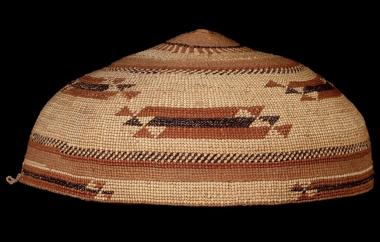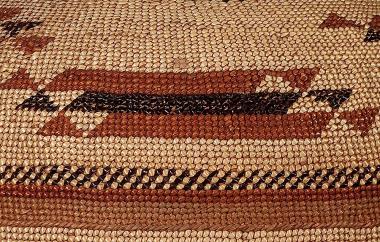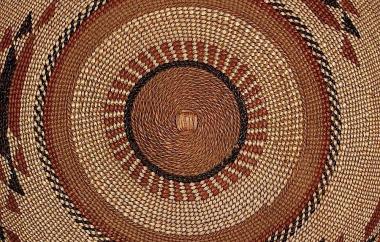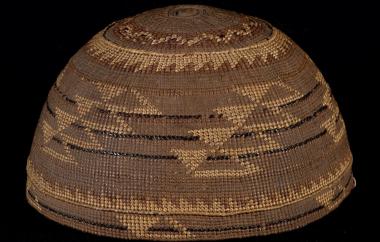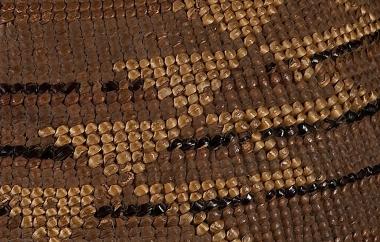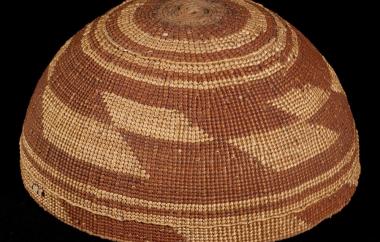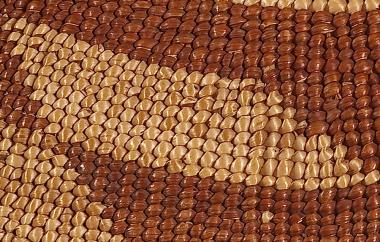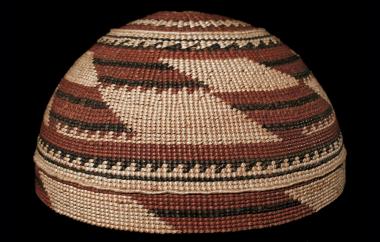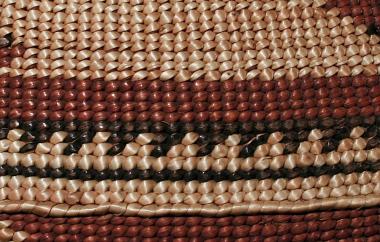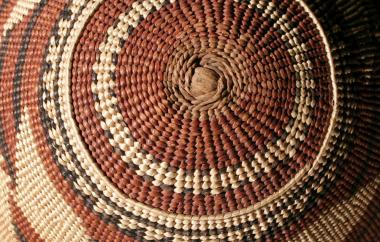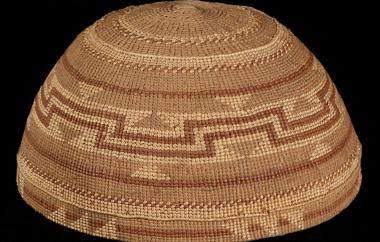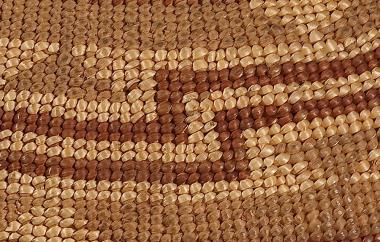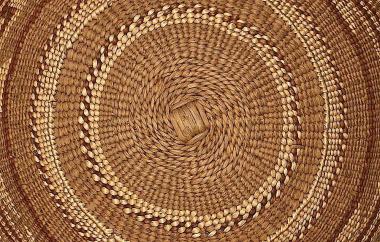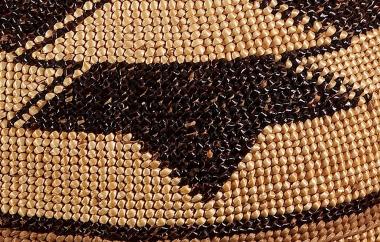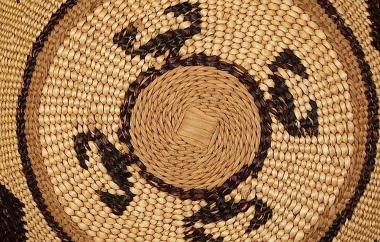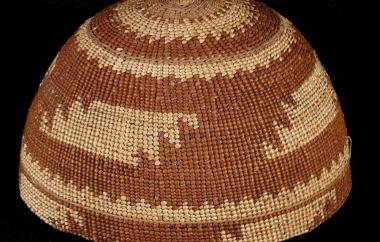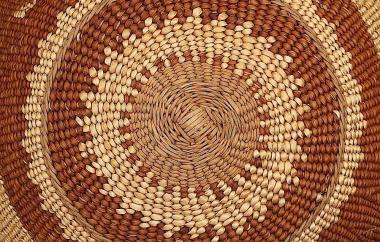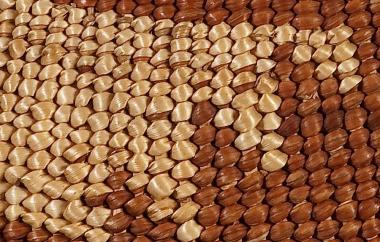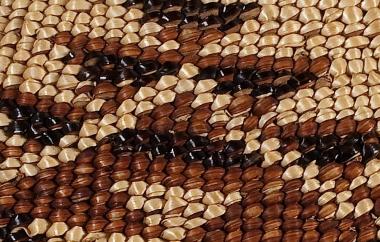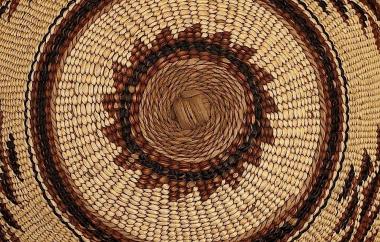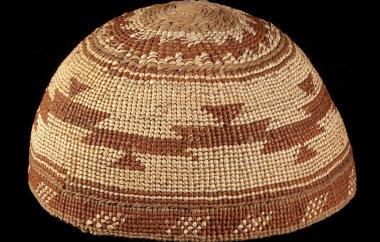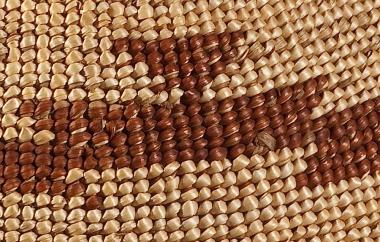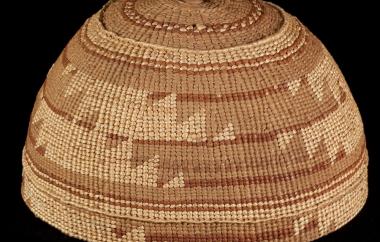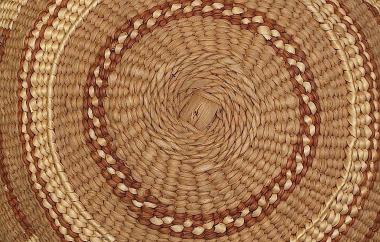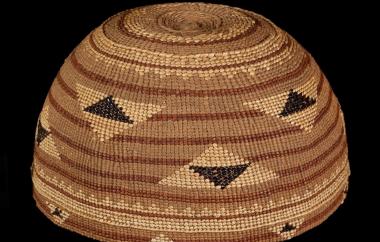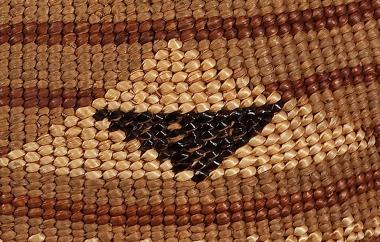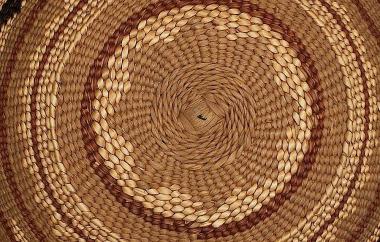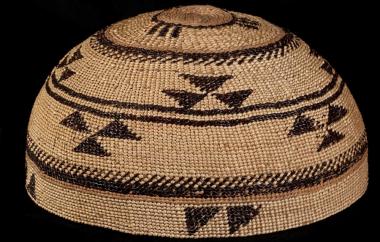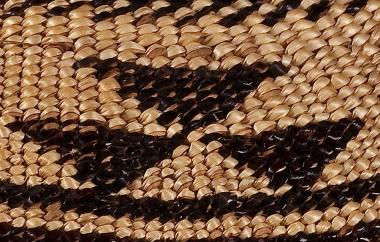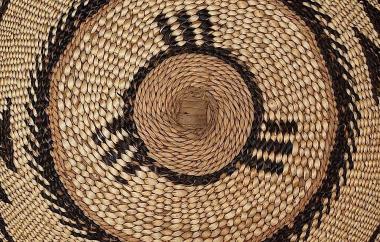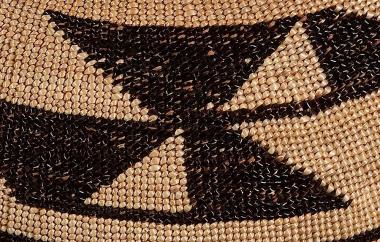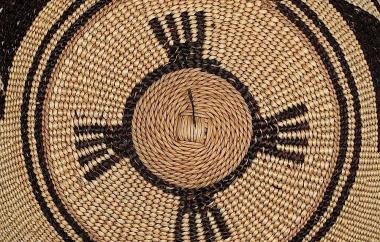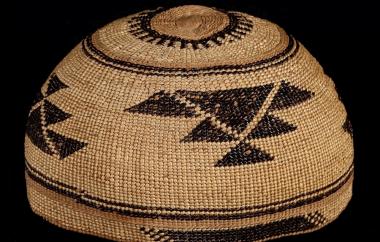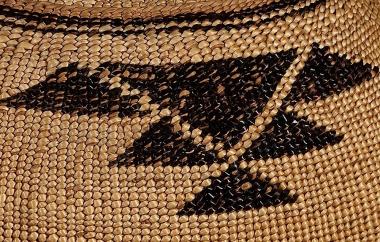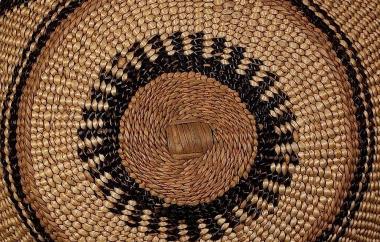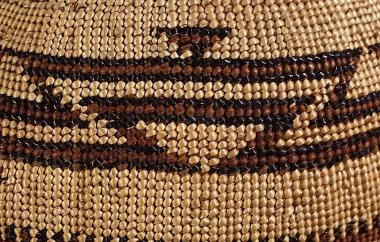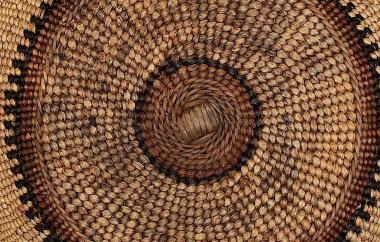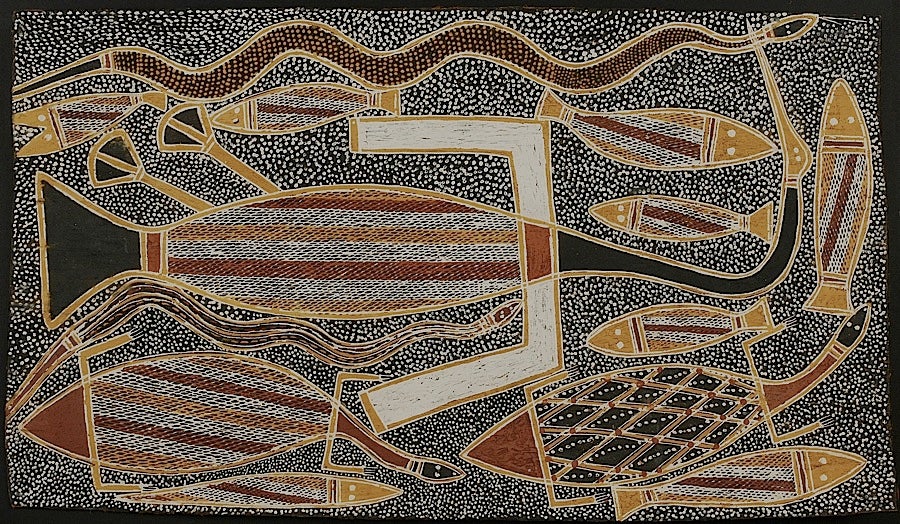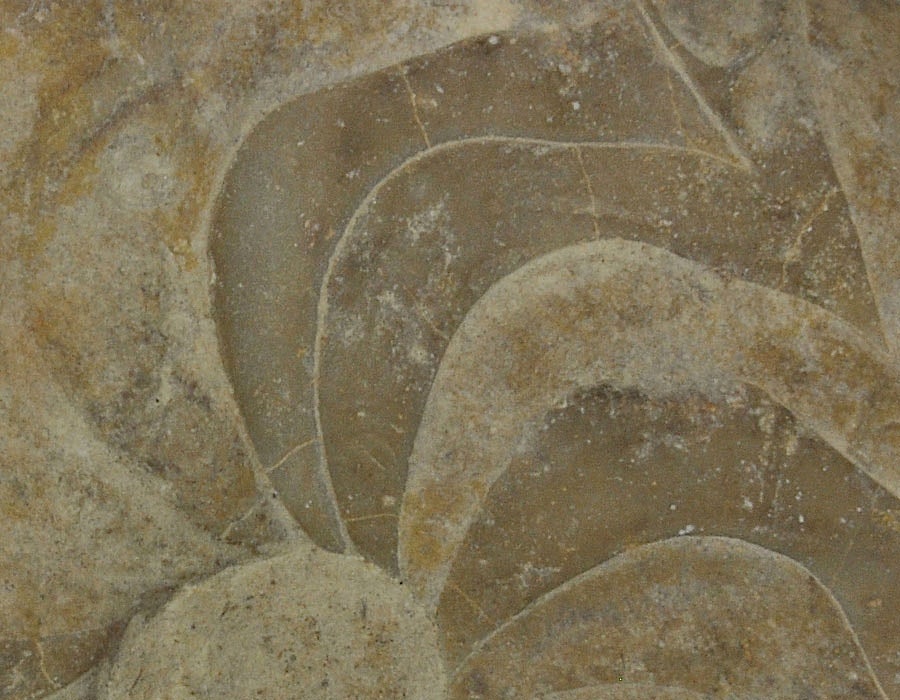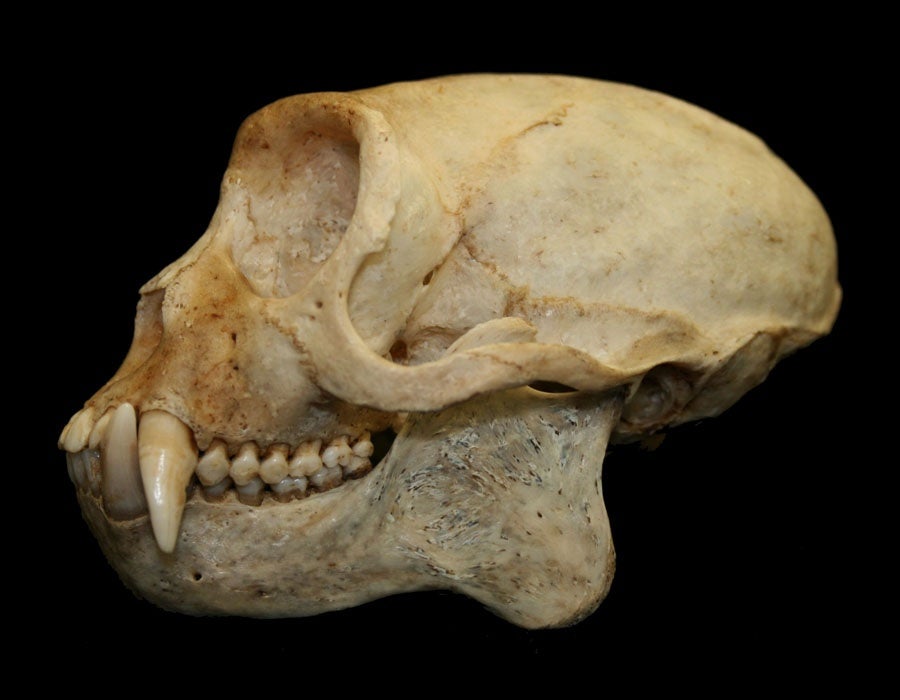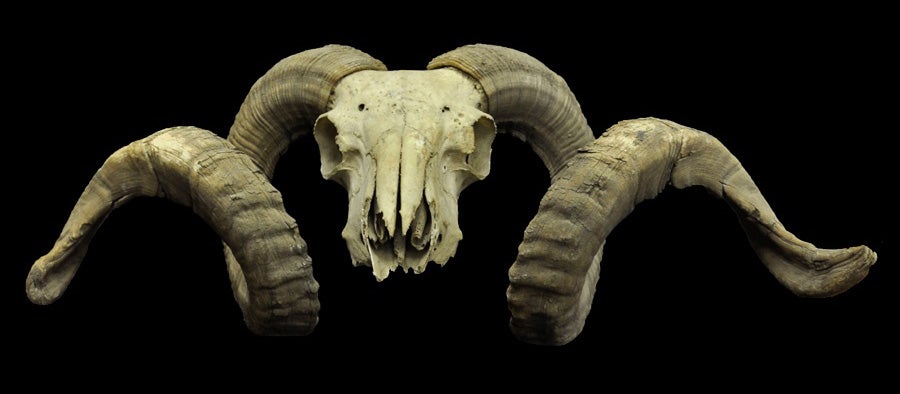Basketry caps from southwest Oregon and northwest California are close-twined rounded hats traditionally worn by women for special occasions and as standard dress. These hats were made primarily by Hoopa, Karuk, Tolowa, Wiyot, Yurok, Shasta, and Klamath peoples. Also called fancy caps, they are known for their geometric design motifs in half-twist overlay, in materials such as beargrass, hazel, and maidenhair fern. Overlay is an embellishment in which an additional material of contrasting color covers the weft element; half-twist overlay is only visible on the outer surface. Hat designs are often segmented into three zones--rim, central design, and base--divided by horizontal banding or a row of wrapped twining above and below the central design.
Shasta caps from northeast California and Oregon (made by Shasta, Pit River, and Klamath peoples) are generally taller with isolated motifs. The basketry caps shown here were made between AD 1890 and 1920, but this tradition continues today among contemporary weavers.
Images © UO Museum of Natural and Cultural History. Production of this gallery was generously supported by The Ford Family Foundation.
Catalog #2-753
Yurok basketry cap
Design of stacked parallelograms.
7 x 3.25 inches
Catalog #2-753
Yurok basketry cap, side detail
Design of stacked parallelograms.
7 x 3.25 inches
Catalog #2-753
Yurok basketry cap, detail of start
Design of stacked parallelograms.
7 x 3.25 inches
Catalog #2-2182
Basketry cap
Overlay in beige and black and two rows of wrapped twining in brown. Design is stepped triangles.
7 x 4 inches
Catalog #2-2182
Basketry cap, detail of start
Overlay in beige and black and two rows of wrapped twining in brown. Design is stepped triangles.
7 x 4 inches
Catalog #2-2182
Basketry cap, side detail
Overlay in beige and black and two rows of wrapped twining in brown. Design is stepped triangles.
7 x 4 inches
Catalog #2-3122
Basketry cap
Overlay covers most of the hat. Two rows of parallelograms in beige. Bought from Mary Metcalf, before 1948.
7.5 x 4 inches
Catalog #2-3122
Basketry cap, detail of start
Overlay covers most of the hat. Two rows of parallelograms in beige. Bought from Mary Metcalf, before 1948.
7.5 x 4 inches
Catalog #2-3122
Basketry cap, side detail
Overlay covers most of the hat. Two rows of parallelograms in beige. Bought from Mary Metcalf, before 1948.
7.5 x 4 inches
Catalog #2-3123
Hoopa or Karuk basketry cap
Overlay design of three rows of parallelograms. Bought from Mary Metcalf, before 1948.
Catalog #2-3123
Hoopa or Karuk basketry cap
Overlay design of three rows of parallelograms. Bought from Mary Metcalf, before 1948.
Catalog #2-3123
Hoopa or Karuk basketry cap, detail of start
Overlay design of three rows of parallelograms. Bought from Mary Metcalf, before 1948.
Catalog #2-3134
Basketry cap
Overlay in light brown and beige. Bought at Yreka, before 1948.
7.25 x 3.75 inches
Catalog #2-3134
Basketry cap, side detail
Overlay in light brown and beige. Bought at Yreka, before 1948.
7.25 x 3.75 inches
Catalog #2-3134
Basketry cap, detail of start
Overlay in light brown and beige. Bought at Yreka, before 1948.
7.25 x 3.75 inches
Catalog #2-6278
Basketry cap
Overlay in light beige and black, design is a leaf or half star in black, and a frog-like motif in black on the base.
6.5 x 3.5 inches
Catalog #2-6278
Basketry cap, side detail
Overlay in light beige and black, design is a leaf or half star in black, and a frog-like motif in black on the base.
6.5 x 3.5 inches
Catalog #2-6278
Basketry cap, detail of start
Overlay in light beige and black, design is a leaf or half star in black, and a frog-like motif in black on the base.
6.5 x 3.5 inches
Catalog #2-6771
Basketry cap
Overlay in brown and beige. Attributed to Mrs. Child, 1897.
7 x 4 inches
Catalog #2-6771
Basketry cap, detail of start
Overlay in brown and beige. Attributed to Mrs. Child, 1897.
7 x 4 inches
Catalog #2-6771
Basketry cap, side detail
Overlay in brown and beige. Attributed to Mrs. Child, 1897.
7 x 4 inches
Catalog #2-6774
Basketry cap
Overlay, with beige and black design of stepped triangles in a zigzag. Collected 1903.
6.75 x 4 inches
Catalog #2-6774
Basketry cap, side detail
Overlay, with beige and black design of stepped triangles in a zigzag. Collected 1903.
6.75 x 4 inches
Catalog #2-6774
Basketry cap, detail of start
Overlay, with beige and black design of stepped triangles in a zigzag. Collected 1903.
6.75 x 4 inches
Catalog #2-6863
Basketry cap
Overlay in light beige covering most of the hat. Design is a band of triangles and trapezoids. Attributed to Mrs. Child, 1897.
7 x 4 inches
Catalog #2-6863
Basketry cap, side detail
Overlay in light beige covering most of the hat. Design is a band of triangles and trapezoids. Attributed to Mrs. Child, 1897.
7 x 4 inches
Catalog #2-6863
Basketry cap, detail of start
Overlay in light beige covering most of the hat. Design is a band of triangles and trapezoids. Attributed to Mrs. Child, 1897.
7 x 4 inches
Overlay in light beige. Design is two wide bands of diagonal zigzags. Attributed to Mrs. Child, 1897.
7 x 4.25 inches - Catalog #2-6864
Catalog #2-6864
Basketry cap, side detail
Overlay in light beige. Design is two wide bands of diagonal zigzags. Attributed to Mrs. Child, 1897.
7 x 4.25 inches
Catalog #2-6864
Basketry cap, detail of start
Overlay in light beige. Design is two wide bands of diagonal zigzags. Attributed to Mrs. Child, 1897.
7 x 4.25 inches
Catalog #2-6866
Basketry cap
Overlay in beige, brown, and black. Design of nested triangles over horizontal brown bands, and a flower-like motif on the base. Labeled, “Given her by _ H Leox of Klamath after his wife's death. Xmas 1895."
7 x 4 inches
Catalog #2-6866
Basketry cap, side detail
Overlay in beige, brown, and black. Design of nested triangles over horizontal brown bands, and a flower-like motif on the base. Labeled, “Given her by _ H Leox of Klamath after his wife's death. Xmas 1895."
7 x 4 inches
Catalog #2-6866
Basketry cap, detail of start
Overlay in beige, brown, and black. Design of nested triangles over horizontal brown bands, and a flower-like motif on the base. Labeled, “Given her by _ H Leox of Klamath after his wife's death. Xmas 1895."
7 x 4 inches
Catalog #2-6867
Basketry cap
Overlay covers most of the hat in white and black. Double horizontal black bands with triangles in groups of three below and above. Labeled "Cal Xmas from Lee 1896."
7 x 3.75 inches
Catalog #2-6867
Basketry cap, side detail
Overlay covers most of the hat in white and black. Double horizontal black bands with triangles in groups of three below and above. Labeled "Cal Xmas from Lee 1896."
7 x 3.75 inches
Catalog #2-6867
Basketry cap, detail of start
Overlay covers most of the hat in white and black. Double horizontal black bands with triangles in groups of three below and above. Labeled "Cal Xmas from Lee 1896."
7 x 3.75 inches
Catalog #2-6869
Basketry cap
Overlay covers most of the hat in white and black. Stacked parallelograms
in black with a white triangle inside, and a sunburst-like motif on the base. Collected in 1896.
7 x 4 inches
Catalog #2-6869
Basketry cap, side detail
Overlay covers most of the hat in white and black. Stacked parallelograms
in black with a white triangle inside, and a sunburst-like motif on the base. Collected in 1896.
7 x 4 inches
Catalog #2-6869
Basketry cap, detail of start
Overlay covers most of the hat in white and black. Stacked parallelograms in black with a white triangle inside, and a sunburst-like motif on the base. Collected in 1896.
7 x 4 inches
Catalog #2-17178
Basketry cap
Overlay covers most of the hat in white and black. Stepped triangle motif over a larger triangle.
6.5 x 4 inches
Catalog #2-17178
Basketry cap, side detail
Overlay covers most of the hat in white and black. Stepped triangle motif over a larger triangle.
6.5 x 4 inches
Catalog #2-17178
Basketry cap, detail of start
Overlay covers most of the hat in white and black. Stepped triangle motif over a larger triangle.
6.5 x 4 inches
Catalog #2-18398
Klamath or Yurok basketry cap
Overlay in beige, brown, and black. Two narrow rust and dark brown notched stripes bracket a larger central geometric band.
7 x 4 inches
Catalog #2-18398
Klamath or Yurok basketry cap, side detail
Overlay in beige, brown, and black. Two narrow rust and dark brown notched stripes bracket a larger central geometric band.
7 x 4 inches
Catalog #2-18398
Klamath or Yurok basketry cap, detail of start
Overlay in beige, brown, and black. Two narrow rust and dark brown notched stripes bracket a larger central geometric band.
7 x 4 inches

